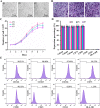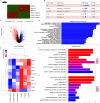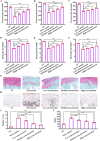CD146-positive adipose-derived stem cells subpopulation enriched by albumin magnetic sphere ameliorates knee osteoarthritis pain and promotes cartilage repair
- PMID: 38102700
- PMCID: PMC10724978
- DOI: 10.1186/s13018-023-04434-9
CD146-positive adipose-derived stem cells subpopulation enriched by albumin magnetic sphere ameliorates knee osteoarthritis pain and promotes cartilage repair
Abstract
Background: The use of adipose stem cell (ADSCs) subpopulations in cartilage repair remains poorly characterized. In this study, we constructed an albumin magnetic sphere with specific targeting of CD146 (CD146-AMs) for sorting a subpopulation of CD146-positive ADSCs (CD146 + ADSCs) and explored the role of CD146 + ADSCs on joint pain and cartilage repair in rats with knee osteoarthritis (KOA).
Methods: CD146-AMs were prepared and analyzed in materialistic characterization tests. Subpopulations of CD146 + ADSCs were sorted using CD146-AMs. Surface labeling, viability, and proliferation of a subpopulation of CD146 + ADSCs were evaluated in vitro. Molecular characterization of mRNA and protein expression profiles was analyzed by microarray. A rat KOA pain model was established by the iodoacetic acid method, and KOA pain and the promotion of cartilage repair were assessed after treatment with bilateral joint cavity injections of CD146 + ADSCs.
Results: The CD146-AMs prepared in this study had an average particle size of 242.63 ± 6.74 nm, an average potential of 33.82 ± 3.53 mv, and high CD146 targeting and low cytotoxicity. The positive rate of enriched CD146 + ADSCs was 98.21% and showed a high level of stem cell marker expression and good cell viability. Gene and protein expression profiles showed that CD146 + ADSCs have different cellular functions, especially in regulating inflammation. In the KOA model, low, medium and high concentrations of CD146 + ADSCs were able to improve KOA pain and promote cartilage repair in a concentration-dependent trend.
Conclusions: The CD146-AMs prepared in this study were able to safely and efficiently sort out the CD146 + ADSCs subpopulation. The subpopulation of CD146 + ADSCs has a unique molecular profile that ameliorates KOA pain and repairs cartilage damage in rats, providing a new idea for KOA treatment.
Keywords: Adipose-derived stem cells; CD146; Cartilage; Knee osteoarthritis; Magnetic sphere.
© 2023. The Author(s).
Conflict of interest statement
The authors declare no competing interests.
Figures






Similar articles
-
Enrichment of CD146+ Adipose-Derived Stem Cells in Combination with Articular Cartilage Extracellular Matrix Scaffold Promotes Cartilage Regeneration.Theranostics. 2019 Jul 9;9(17):5105-5121. doi: 10.7150/thno.33904. eCollection 2019. Theranostics. 2019. PMID: 31410204 Free PMC article.
-
Specific lipid magnetic sphere sorted CD146-positive bone marrow mesenchymal stem cells can better promote articular cartilage damage repair.BMC Musculoskelet Disord. 2024 Apr 1;25(1):253. doi: 10.1186/s12891-024-07381-6. BMC Musculoskelet Disord. 2024. PMID: 38561728 Free PMC article.
-
Effect of a subset of adipose-derived stem cells isolated with liposome magnetic beads to promote cartilage repair.J Cell Mol Med. 2021 May;25(9):4204-4215. doi: 10.1111/jcmm.16470. Epub 2021 Mar 25. J Cell Mol Med. 2021. PMID: 33768729 Free PMC article.
-
Intraarticular injection of bone marrow-derived mesenchymal stem cells enhances regeneration in knee osteoarthritis.Knee Surg Sports Traumatol Arthrosc. 2020 Dec;28(12):3827-3842. doi: 10.1007/s00167-020-05859-z. Epub 2020 Jan 31. Knee Surg Sports Traumatol Arthrosc. 2020. PMID: 32006075 Free PMC article. Review.
-
The Mechanism by Which Estrogen Level Affects Knee Osteoarthritis Pain in Perimenopause and Non-Pharmacological Measures.Int J Mol Sci. 2025 Mar 7;26(6):2391. doi: 10.3390/ijms26062391. Int J Mol Sci. 2025. PMID: 40141035 Free PMC article. Review.
Cited by
-
Similar efficacy of intra-articular hyaluronic acid injections and other biologically active injections in patients with early stages knee osteoarthritis: a level I meta-analysis.Arch Orthop Trauma Surg. 2024 Dec 18;145(1):68. doi: 10.1007/s00402-024-05614-w. Arch Orthop Trauma Surg. 2024. PMID: 39694921
References
-
- Ng WH, Jamaludin NI, Sahabuddin FNA, Ab Rahman S, Ahmed Shokri A, Shaharudin S. Comparison of the open kinetic chain and closed kinetic chain strengthening exercises on pain perception and lower limb biomechanics of patients with mild knee osteoarthritis: a randomized controlled trial protocol. Trials. 2022;23(1):315. doi: 10.1186/s13063-022-06153-8. - DOI - PMC - PubMed
-
- Sasaki R, Honda Y, Oga S, Fukushima T, Tanaka N, Kajiwara Y, Nakagawa K, Takahashi A, Sakamoto Y, Morita H, Kondo Y, Okita S, Kondo Y, Goto K, Kataoka H, Sakamoto J, Okita M. Effect of exercise and/or educational interventions on physical activity and pain in patients with hip/knee osteoarthritis: a systematic review with meta-analysis. PLoS ONE. 2022;17(11):e0275591. doi: 10.1371/journal.pone.0275591. - DOI - PMC - PubMed
MeSH terms
Substances
Grants and funding
- Zdzk-04/Project of Key Medical Discipline of Pudong Hospital of Fudan University
- PKJ2020-Y50/Special Fund for the Development of the Science and Economic Commission of Shanghai Pudong
- PWYgy2021-04/328 Outstanding Clinical Discipline Project of Shanghai Pudong
- PWRq 2022-17/Young Medical Talents Training Program of Pudong Health Committee of Shanghai
- PJ202004/"Pu Jing Project" of Shanghai Pudong Hospital
LinkOut - more resources
Full Text Sources

